California wildflowers in bloom
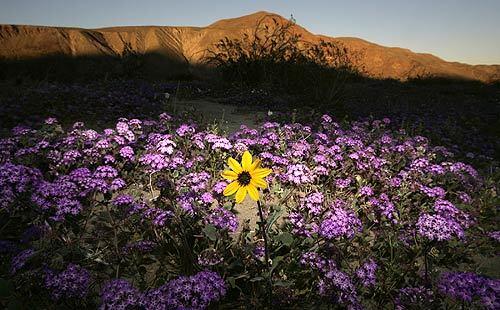
A dune sunflower sticks up above the violet sand-hugging desert verbena in Coyote Canyon inside Anza-Borrego Desert State Park. (Don Bartletti / Los Angeles Times)
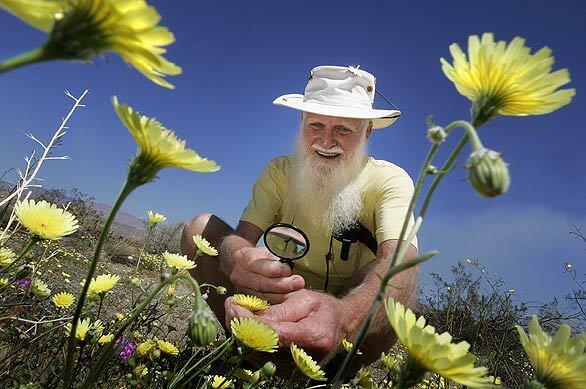
San Diego resident Joe Kelly takes a closer look at yellow desert dandelion in Galleta Meadows at the junction of Borrego Springs and Henderson Canyon roads. The retired salesman says he’s staying in Borrego Springs for four days, “... on a vacation from vacation.” (Don Bartletti / Los Angeles Times)
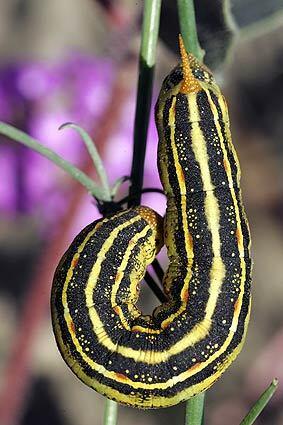
Caterpillars like this one are feeding in abundance in Coyote Canyon, taking their pick of the wildflower bounty. (Don Bartletti / Los Angeles Times)
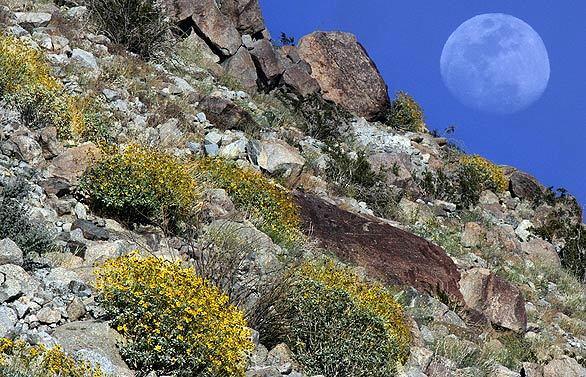
The rising moon slips over the eastern wall of Coyote Canyon, where brittlebush dot the landscape with golden bouquets. (Don Bartletti / Los Angeles Times)
Advertisement
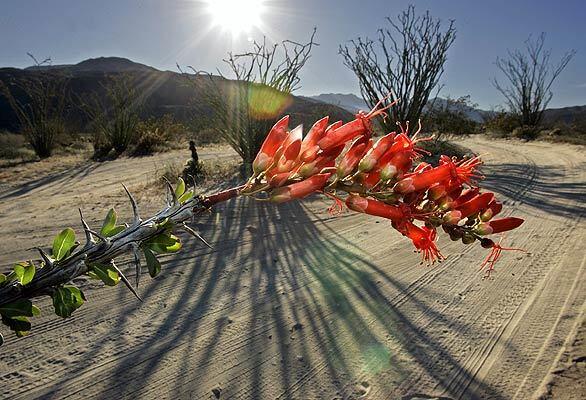
The Day-Glo orange flowers of the thorny-branched ocotillo bushes are reaching full bloom in Coyote Canyon. The packed sand road through the canyon is maintained and passable for most vehicles, but the soft sides of the road should be avoided. (Don Bartletti / Los Angeles Times)
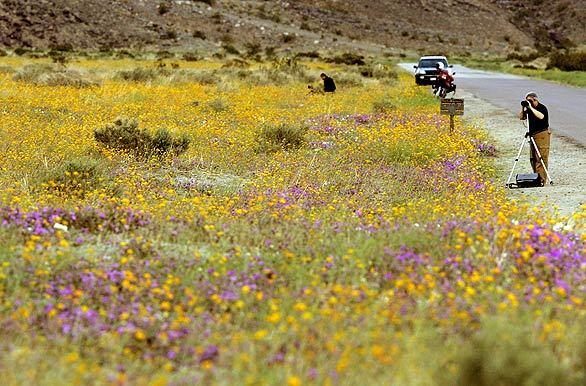
Michael Plack of Rancho San Diego photographs a carpet of yellow desert dandelion and purple sand verbena along Henderson Canyon Road. (Don Bartletti / Los Angeles Times)
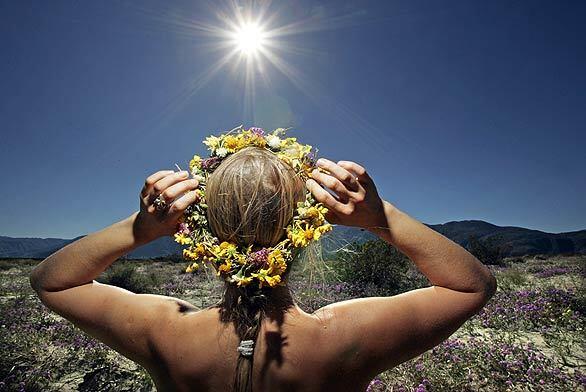
Yelena Sedochenkova gets in on the wildflower fun with a floral hair bouquet as she enjoys the sun and desert blooms after two days of hiking and camping in Coyote Canyon. (Don Bartletti / Los Angeles Times)
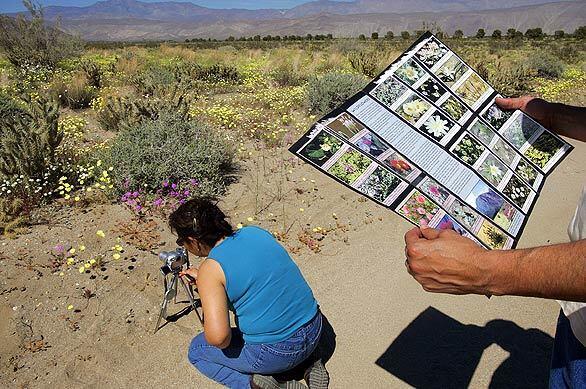
Larry Elwell of Mira Loma has a state park guide to desert wildflowers in hand while his wife, Cindy, photographs yellow desert dandelion. Galleta Meadows, at the junction of Borrego Springs and Henderson Canyon roads, is in full bloom with a variety of annuals and cactuses. Rangers say steady winter rains have brought the most color to local deserts in several years. (Don Bartletti / Los Angeles Times)
Advertisement
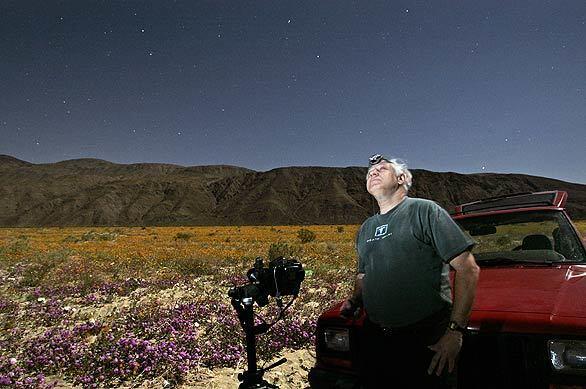
Photographed by the light of the moon, Dennis Mammana of Borrego Springs looks up at the stars above a huge field of wildflowers on Henderson Canyon Road. The astronomy photographer and lecturer pulled over to photograph the night sky and the best desert wildflower bloom in several years. (Don Bartletti / Los Angeles Times)
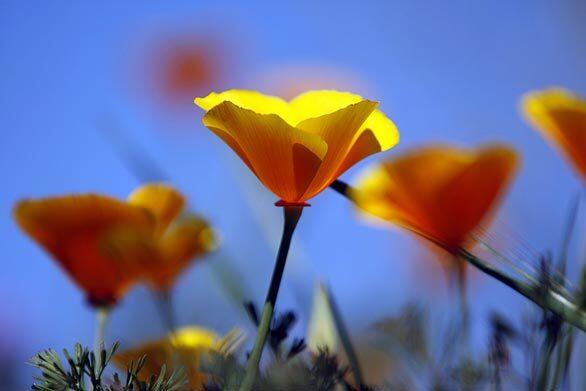
California poppies are in bloom on Turnbull Canyon Rd. in Whittier. (Francine Orr / Los Angeles Times)
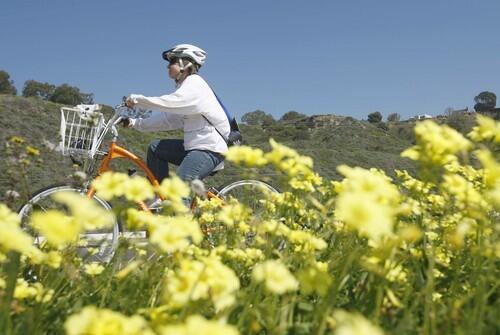
A cyclist rides past Oxalis albicans (California Wood Sorrel) also known as sour grass, at Will Rogers State Beach in Pacific Palisades. (Francine Orr / Los Angeles Times)
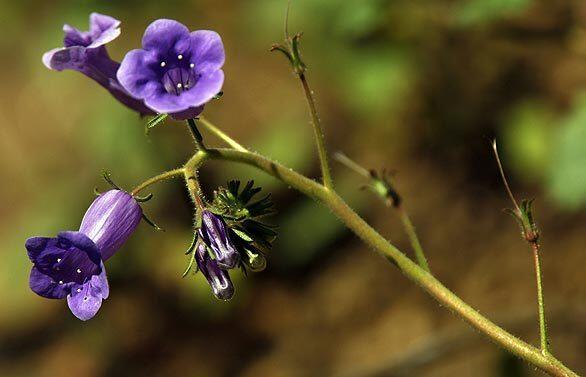
Native Phacelia in bloom on Turnbull Canyon Rd. in Whittier. (Francine Orr / Los Angeles Times)
Advertisement
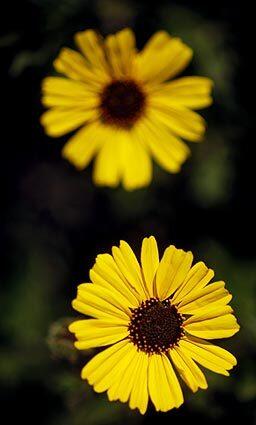
California bush sunflowers are in bloom on Turnbull Canyon Rd. in Whittier. (Francine Orr / Los Angeles Times)
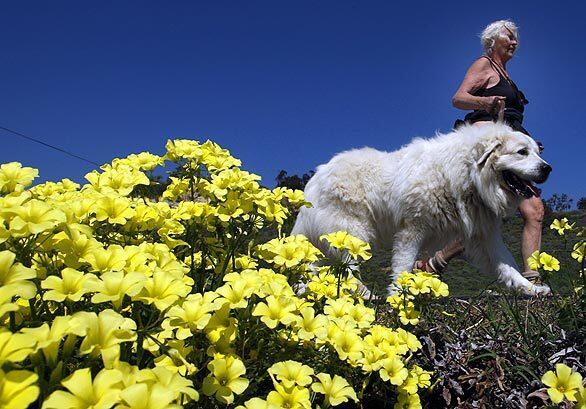
Pat Baker walks “Bear” an 8-year-old Great Pyrenees past Oxalis albicans (California Wood Sorrel) also known as sour grass at Will Rogers State Beach. (Francine Orr / Los Angeles Times)
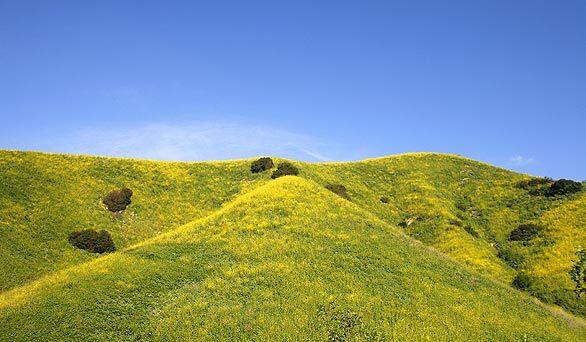
Non-Native Black Mustard blankets the hills on Turnbull Canyon Rd. in Whittier. (Francine Orr / Los Angeles Times)
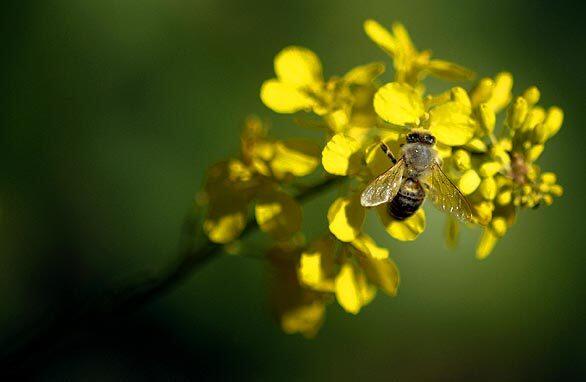
A bee lands on a Non-Native Black Mustard blankets the hills on Turnbull Canyon Rd. in Whittier. (Francine Orr / Los Angeles Times)
Advertisement
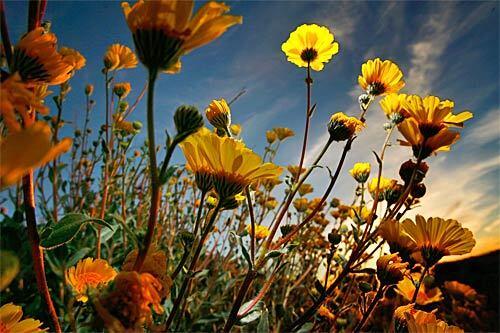
California wildflowers
Desert sunflowers bloom at Amboy Crater National Natural Landmark, a 250-foot-high cinder-cone crater in the Mojave Desert. The area is managed by the Bureau of Land Management and sits between the California towns of Barstow and Needles. (David McNew / Getty Images)
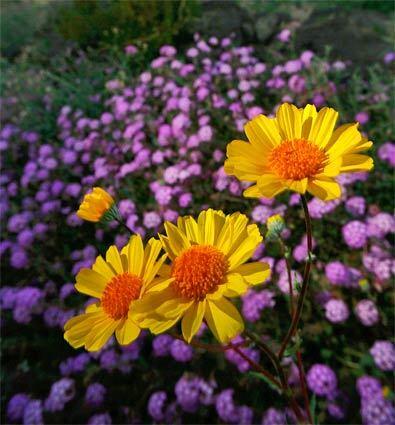
California wildflowers
Desert sunflowers (yellow) and desert sand verbena (purple) at Amboy Crater National Natural Landmark in the Mojave Desert. (David McNew / Getty Images)
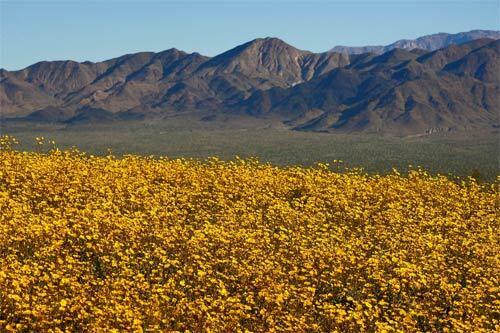
California wildflowers
A panoramic shot of desert sunflowers blooming near Amboy Crater National Natural Landmark in the Mojave Desert. (David McNew / Getty Images)
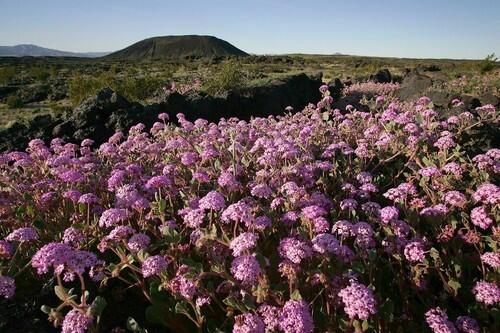
California wildflowers
Blooms of desert sand verbena are found near Amboy Crater Ntaional Natural Landmark, a BLM-managed area of the Mojave Desert. (David McNew / Getty Images)
Advertisement
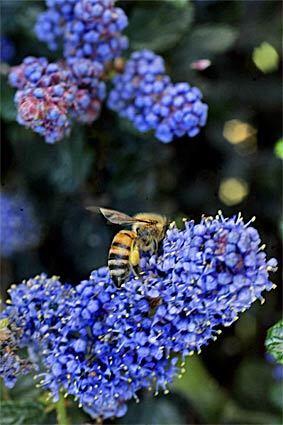
California wildflowers
Ceanothus is a fragrant bush found in the Santa Monica and San Gabriel mountains and other areas of Southern California. There are many types, and blooms can be purplish, blue or bright white. This plant is sometimes referred to as California lilac, though it is not part of the lilac family. (Karen Tapia-Andersen / Los Angeles Times)
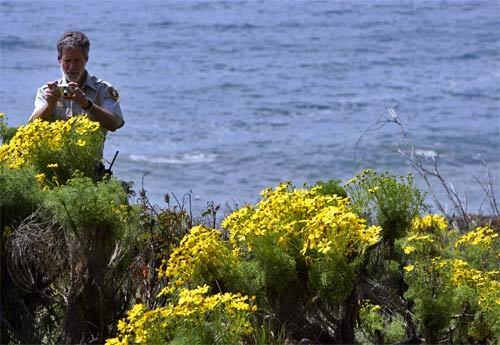
California wildflowers
Giant coreopsis bloom near the coast, such as La Jolla Canyon and Circle X Ranch in the Santa Monica Mountains. (Stephen Osman / Los Angeles Times)
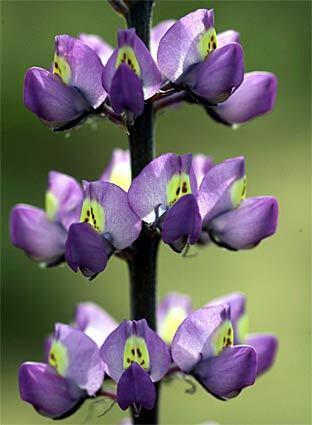
California wildflowers
Many types of lupine--some in the deserts, some in the mountains--are native to Southern California. This is an arroyo lupine. (Mark Boster / Los Angeles Times)
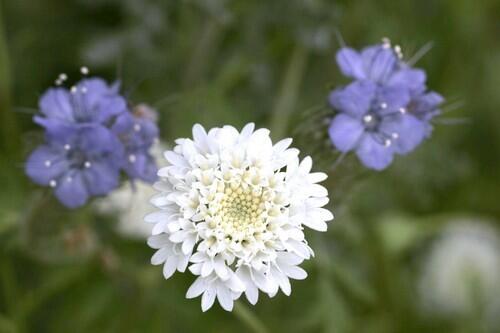
California wildflowers
Desert pincushion, also known as Chaenactis fremontii, is a white-flowering species of disk flowers that look like a dense pincushion. Pale yellow reproductive parts emerge from open flowers while unopened flowers resemble tiny cotton balls. (Mark Boster / Los Angeles Times)
Advertisement
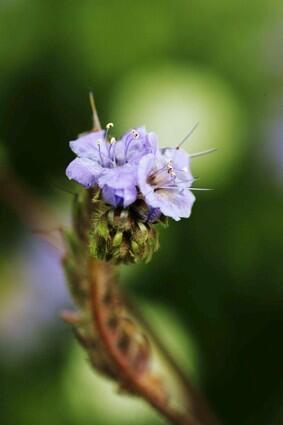
California wildflowers
Many types of phacelia are found in Southern California. The pictured flower is commonly called blue-eyed scorpion weed. (Mark Boster / Los Angeles Times)
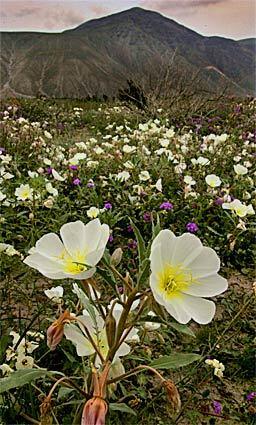
California wildflowers
Dune evening primroses bloom in many desert areas, including Anza-Borrego Desert State Park. (Mark Boster / Los Angeles Times)
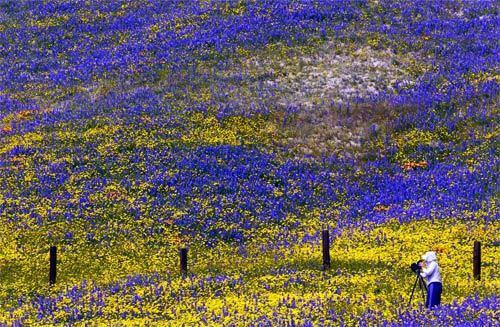
California wildflowers
In years with plenty of rain, wildflowers can turn hillsides yellow, purple and orange. This hillside in the Grapevine area of the 5 Freeway was transformed due to a rainy 2003. (Robbin Goddard / Los Angeles Times)
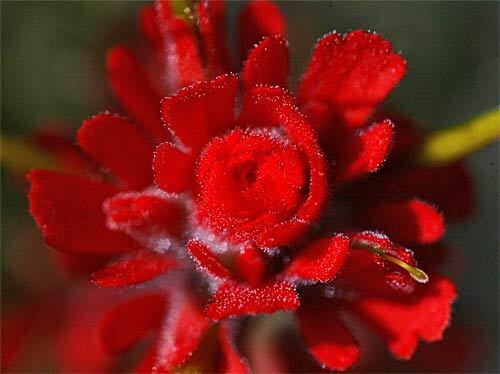
California wildflowers
Indian paintbrush adds intense blotches of red to the trails and canyons of Southern California. (Mark Boster / Los Angeles Times)
Advertisement
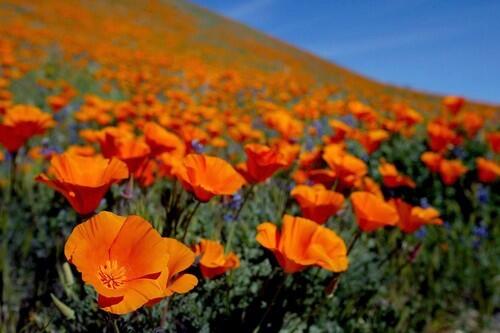
California wildflowers
California poppies created an orange explosion during the 2003 wildflower season, which followed heavy winter rains. (Anne Cusack / Los Angeles Times)
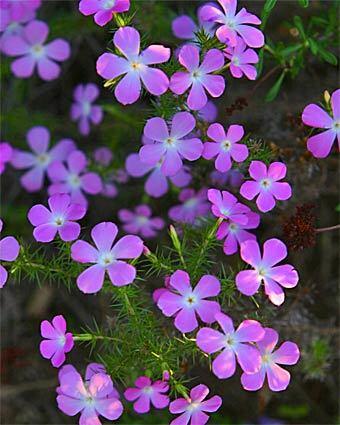
California wildflowers
Prickly phlox, found in many local mountain areas, particularly the Santa Monica Mountains, flower in soft or vibrant pinks. (Al Seib / Los Angeles Times)
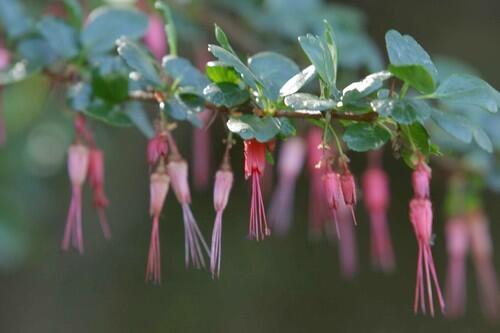
California wildflowers
Fuchsia-flowered gooseberry blooms in spring and remains dormant the rest of the year. The blooms dangle from a spiky branches. (Al Seib / Los Angeles Times)



